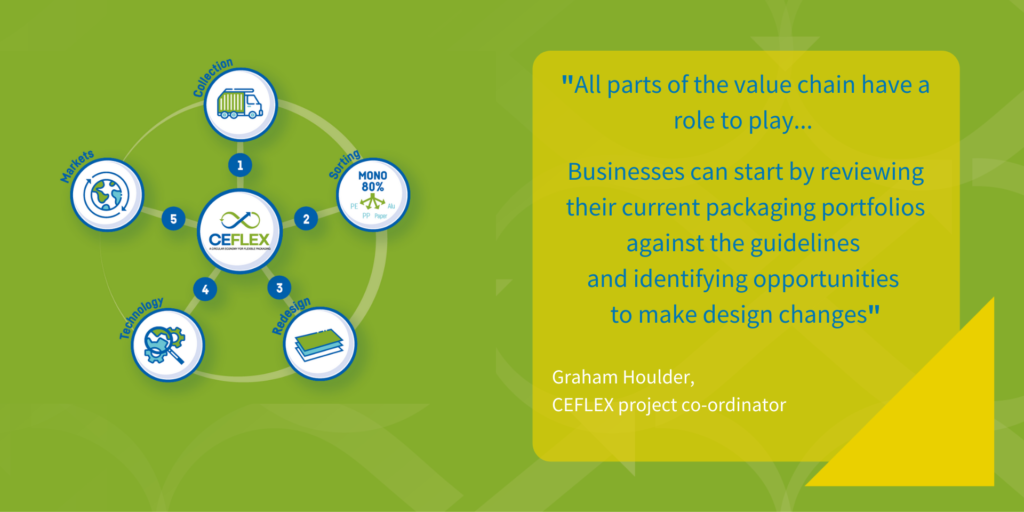PRESS RELEASE
A comprehensive set of guidelines to help the flexible packaging value chain design recyclable consumer packaging solutions and accelerate a circular economy was officially launched today (09.07.20).
Produced by the Circular Economy for Flexible Packaging (CEFLEX) initiative – a partnership of over 160 European companies, associations, and organisations – the Designing for a Circular Economy (D4ACE) guidelines have been developed collaboratively with the entire flexible packaging value chain.
Providing a catalyst for change across Europe, the new D4ACE guidelines aim to produce higher quality recycled materials to be kept in the economy and used in a wider number of sustainable end markets. In turn, this will help support much needed investment in sorting and recycling infrastructure to make all flexible packaging circular.
Focused on polyolefin-based structures as these represent over 80% of consumer flexible packaging on the European market, the guidelines provide advice on the key elements of flexible packaging including the materials used, barrier layers and coatings, size, shape, inks and adhesives. They build on the work of Project Barrier, a pioneer project of the New Plastics Economy Initiative, and current best practices, to align and accelerate progress already made.
Graham Houlder, CEFLEX project coordinator, said: “Achieving a circular economy is a significant challenge. It will only be accomplished through wide collaboration, innovation and investment. The Designing for a Circular Economy Guidelines (D4ACE) show the required level of collaboration is possible, bringing hundreds of stakeholders and wider industry consultation together to define a collective set of circular economy design principles for all consumer flexible packaging.”
“Only by working together like this can we all move forward and meet the flexible packaging value chain’s own ambitious sustainability goals and prevent waste and pollution.”
Mr Houlder continued: “Based on best in class sorting and recycling processes in Europe, the D4ACE guidelines have been created to help anyone working in the flexible packaging value chain. The document will guide brands and retailers who play a key role in specifying consumer packaging to make informed design choices so that all flexible packaging is suitable for sorting and recycling but retains the functionality needed for its primary purpose, protecting the product.”
In most cases, this will mean favouring mono-material over multi-material flexible packaging formats as these are the most efficient to sort and recycle. This preference for mono-material flexible packaging solutions brings with it a range of challenges to deliver similar functionality and the possibility to use existing packing machinery.
Brand owners and retailers will need to work with their packaging converters, material producers and others in the value chain to develop mono-material solutions to these new challenges.
Mr Houlder added: “All parts of the value chain have a role to play today. Businesses can start by reviewing their current packaging portfolios against the guidelines and identifying opportunities to make design changes.
“Once a portfolio has been evaluated against the guidelines, businesses can engage with their suppliers, internal and external customers and get the whole value chain working towards the same goals. The result will be a greater percentage of flexible packaging in the waste stream that when collected, can be readily sorted and recycled and returned to the economy to replace virgin plastic.”
“Widespread adoption and implementation of the guidelines is essential to support establishing collection, sorting, and recycling systems for flexible packaging in all European countries. CEFLEX is working in parallel to realise these investments and systems to ensure the circular economy for flexible packaging is also sustainable”
As an initiative, CEFLEX aims to provide forward-looking and future-proof solutions for a circular economy and the guidelines will therefore be reviewed on a regular basis. What is not possible today, might well be common practice tomorrow. A second phase of activity already underway will see independent testing of many more flexible packaging structures to help develop additional guidance.
To obtain the Designing for a Circular Economy Guidelines (D4ACE), go to https://ceflex.eu/guidelines/

